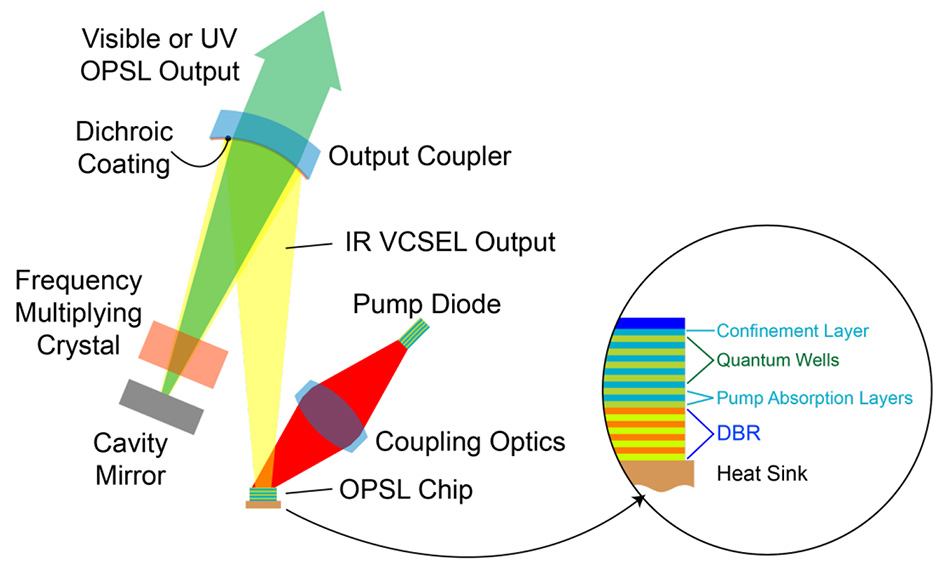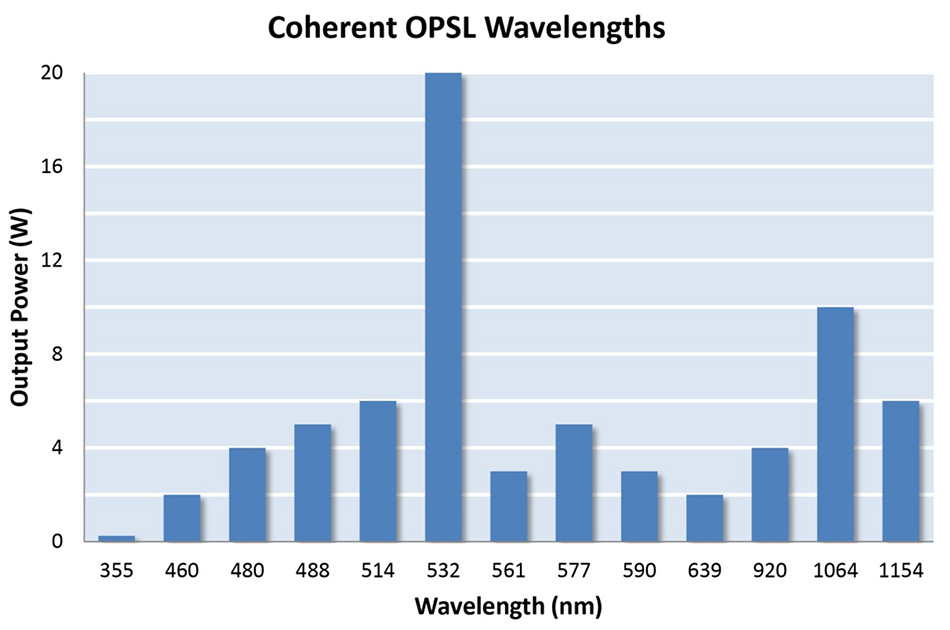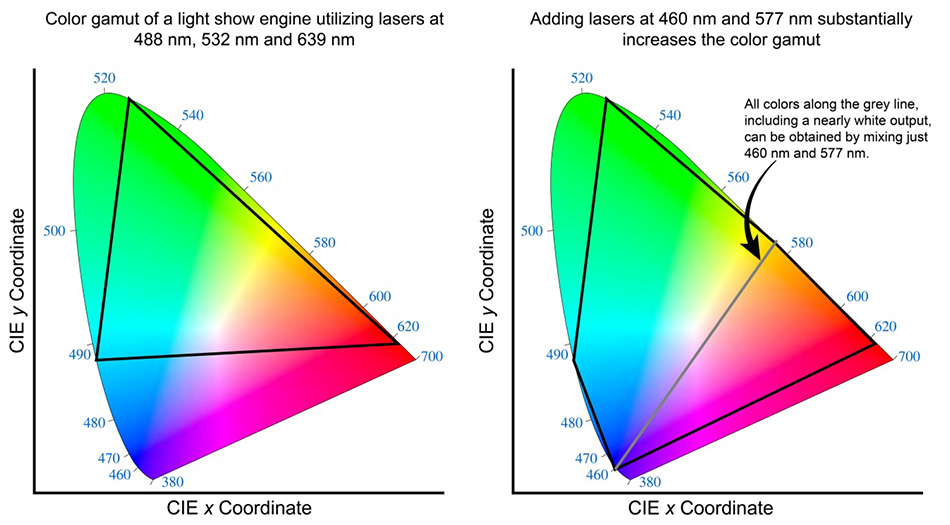WHITE PAPER
OPSL Advantages Whitepaper Series #1:
Wavelength Flexibility
Overview
The Optically Pumped Semiconductor Laser (OPSL) technology offers numerous advantages over other types of CW lasers, including wavelength flexibility. In particular, an OPSL can be designed to match the wavelength requirements of the application, which represents a paradigm shift over legacy technologies.
OPSL Advantages White Papers in this series:
#1. Wavelength flexibility
#2. Invariant beam properties
#3. No mode noise ("green noise")
#4. Superior reliability - huge installed base

Wavelength Flexibility without Compromise
The optically pumped semiconductor laser (OPSL) is a unique technology that combines the most desirable attributes of laser diodes, DPSS (Diode Pumped Solid State) and Ion lasers, while eliminating a number of their compromising limitations. For instance, many ion gas lasers and first generation diode-pumped solid-state lasers were all capable of producing an output beam with the good quality TEM00 mode required by many applications, including confocal microscopy, flow cytometry and holography. Unfortunately their output wavelengths were limited to the handful of emission lines determined by the gain material, e.g., 488 nm for ion lasers and 1064 nm (and its harmonics) for DPSS lasers. Major applications have historically been fit, and sometime less than optimized, in order to match one of these fixed wavelengths, most notably 488 nm in life sciences. On the other hand, diode lasers based on binary and ternary semiconductors can be fabricated to operate at an ever growing range of visible and near-IR wavelengths. However, these devices are typically so-called edge emitters, where the light is emitted from a small (micron sized) and asymmetrical output facet. As a result, the output is highly divergent, asymmetric, not diffraction limited and often astigmatic. For any application requiring conventional beam properties, these require a variety of optics to reshape and spatially filter the beam. Also, the high intensity at the small output facet means that power scaling is limited and usually requires multiple emitters arranged in a bar or array. This is disadvantageous for applications requiring a highly collimated or focused beam.
The OPSL is a unique laser architecture delivering the wavelength flexibility of laser diodes and the superior beam properties of traditional lasers. In addition, it offers other important advantages, such as power scaling and reduction.
OPSL Architecture
The OPSL is a type of vertical cavity surface emitting laser (VCSEL). In a conventional VCSEL, light is emitted perpendicularly to the junction and exits the face of the diode chip, rather than the edge. The larger output aperture results in a lower divergence beam that can also be symmetric. Unfortunately, electrically pumped VCSELs cannot produce the high power of an edge emitter, because there’s no way to flood a large area with charge carriers without using extended electrodes that would introduce too much optical loss. However, this problem can be avoided by optically pumping the device with a diode laser to create the charge carriers – an approach patented by Coherent. This is the basis of the OPSL.

Figure 1: Schematic illustration of the main functional components in an OPSL.
Figure 1 is a simplified schematic showing the key elements of an OPSL. Pump light from a direct coupled single emitter or fiber-coupled laser diode array is re-imaged into the front surface of the OPSL chip. This monolithic III-V semiconductor chip contains layers of ternary quantum wells (InGaAs) alternated between binary (GaAs) layers. These binary layers are optimized to efficiently absorb pump radiation, resulting in a high population of charge carriers. This leads to population inversion and recombination in the quantum wells, which results in stimulated laser emission. Behind these absorption/emission layers are several alternating high and low index layers that act as a low-loss DBR (Distributed Bragg Reflector) mirror optimized for the desired OPSL output wavelength. The semiconductor chip is mounted on a heat sink to enable efficient cooling over its entire rear surface.
OPSL Wavelength Control
As with other semiconductor-based lasers, the OPSL emits at a wavelength determined by the stoichiometry and physical dimensions of the quantum well structures. Thus, by changing the composition and size of these quantum wells, the OPSL chip can be tailored for different specific output wavelengths as demanded by application – see figure 2.

Figure 2: Coherent offers OPSLs at numerous standard wavelengths and produces custom wavelengths for OEMs.
Most Coherent OPSLs incorporate a birefringent filter inside the cavity. This addresses two peculiarities typical of most diode lasers, including the OPS chip. First of all, this gain chip can emit light over a broader spread of wavelengths compared to lasers based on atomic emission such as an argon ion laser. Moreover, the center wavelength varies slightly from chip to chip, which of course is why laser diode manufacturers charge a premium for selecting laser diodes in a narrow wavelength window. The birefringent filter acts as a narrowband intracavity filter whose transmission wavelength is factory set by rotation about its normal axis. This filter is used to limit the emission to a narrowband – a single longitudinal mode in some models – and also to precisely set the output to the target wavelength.
Coherent OPSLs are based on InGaAs gain chips. That is because these are some of the most reliable, longest lifetime diodes with the highest power characteristics. Quantum well devices of this type can be designed to produce laser emission over a broad range in the near-IR. This is then efficiently converted to visible output via the use of an intracavity frequency doubling crystal. And for applications needing ultraviolet output, some OPSLs are also equipped with a pair of intracavity crystals to perform frequency tripling.
The Value of Wavelength Flexibility
Before the advent of OPSL technology, applications requiring a visible or UV laser beam with milliwatts to watts of continuous wave (CW) power were compelled to use one of the available fixed wavelengths. At first, these were the emission lines of ion gas lasers such as the 488 nm and 514 nm lines of the argon ion laser. Then DPSS lasers at 1064 nm, intracavity doubled to 532 nm, became widely available. There were large gaps in the visible spectrum where no simple laser was available, particularly in the yellow and orange part of the spectrum. The growing demand for lasers emitting in these regions, particularly in the life sciences, could only be met by the krypton ion laser, dye laser, or by solid-state lasers using complex mixing schemes based on inefficient weak emission lines. As a result, applications requiring these wavelengths were often compromised, in order to match one of the available laser wavelengths. The OPSL caused a paradigm change. Today, every established or emerging application is supported by an OPSL designed specifically for the wavelength that optimizes that application. Two very different applications illustrate the advantages of this capability.
Photocoagulation for AMD
Wet-form age-related macular degeneration (AMD) is a leading cause of sight loss and blindness. The condition is characterized by leakages from blood vessels in the macula. This is a small (< 6 mm diameter) area of the retina that is in the center of the field of vision and is responsible for high resolution color vision. Depending on the location of the leaking blood vessel, laser photocoagulation is often a recommended treatment. Here the laser produces controlled, local cauterization, destroying the tiny culprit vessels and preventing further bleeding.
A key to successful photocoagulation is tissue selectivity; that is, closing the target vessels without damaging surrounding tissue in any way. The main differentiator between the leaking vessel and other tissue is the presence of blood. Thus, selectivity can best be achieved by using a laser wavelength that is preferentially absorbed by blood. It also needs to be a visible wavelength to permit the laser to pass benignly through the transparent front of the eye. The main component of blood with visible absorption is oxy-hemoglobin, and for many years, the most commonly used laser wavelength was 532 nm (from a diode-pumped solid-state laser), which is close to a weak absorption peak in oxy-hemoglobin.

Figure 3: The 577 nm OPSL has become the laser of choice for photocoagulation used to treat certain types of wet-form AMD because it exactly matches and absorption maximum for oxy-hemoglobin.
However, the absorption of oxy-hemoglobin actually peaks at 577 nm (see Figure 3). Coherent designed a completely new OPSL laser for this application (Genesis MX577) which delivers 3 watts of output at this specific wavelength. This provided improved vessel closure with reduced thermal loading on the eye, compared to the 532 nm predecessor. Beside this important benefit, the OPSL fast-pulsing (up to 100 kHz) capabilities enabled the use of “micropulsing” to provide a high degree of dosing control to maximize wound-healing response, with a minimum of localized tissue trauma. For these reasons, the 577 nm OPSL has displaced the 532 nm DPSS as the preferred laser in this application.
Light Shows with Superior Color Palette
Light shows represent a very different applications space where the wavelength flexibility of OPSLs has made them the first choice in lasers. The range of colors (the color gamut) that can be generated by a laser lightshow engine depends on the specific laser wavelengths utilized. Traditionally, most color projectors used three lasers – red green and blue (RGB) – where the blue was the argon ion legacy wavelength at 488 nm. However, the human eye is very sensitive to color differences and a challenge with laser light shows has been to generate a true white, technically referred to as D65.
Coherent uses OPSL technology to provide multi-watt power at legacy RGB wavelengths, as well as two important non-legacy wavelengths for light shows: 577 nm originally pioneered for photocoagulation and 460 nm. As shown in figure 4, the latter ensures a broader gamut of colors and more importantly, white can be generated from mixing just two lasers – at 577 and 460 nm. A specific example further illustrates the value of these new wavelengths for the light show designer.

Figure 4: Adding lasers with output at 460 nm and 577 nm substantially increases the color gamut of a traditional RGB lightshow engine, and also simplifies producing “white” output.
In 2011, BMW wanted to launch their new i-series of fuel efficient cars – a major market development for a brand that had always emphasized performance and handling. They selected the Frankfurt International Motor Show (IAA). The launch was conceived by the BlueScope agency and managed by Rockservice, using the services of LOBO, a leading laser light show company based in Aalen, Germany. The overall concept of this high-visibility launch was to unveil each of the cars through a tunnel of blue laser light – see figure 5. In addition, the presentation included other laser effects. These laser elements all had to exactly match the BMW corporate blue color as used in the other visual components (e.g. LED screens) of the launch presentation. But perceived color varies depending on the location, background lighting and other factors. So LOBO needed the ability to smoothly make subtle changes on site to the blue output of their projectors. Achieving a perfect color match would have been very difficult with standard RGB projectors. Instead, LOBO configured their RGB projectors with two blue OPSLs (Coherent Taipan) – at 488 nm and 460 nm. This enabled simple “tweaking” of the blue output to match the perceived color of the other BMW display components in the exhibition hall setting under final lighting conditions.

Figure 5: A display powered by OPSLs helps launch the first fuel-efficient cars from BMW (the i8 and i3) at the 2011 Frankfurt International Motor Show (IAA). Image courtesy of BMW.
Summary
The OPSL offers an unmatched combination of advantages for applications requiring milliwatts to watts of CW laser light. One of the most important is wavelength flexibility which has, for the first time, enabled laser wavelength to be matched to the precise needs of the application, rather than vice versa.